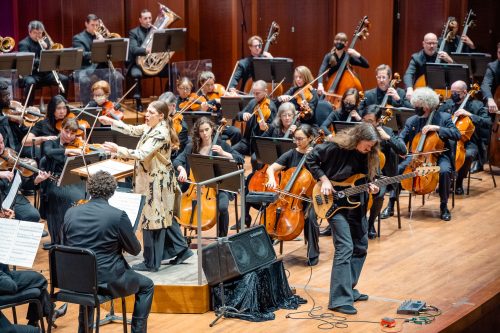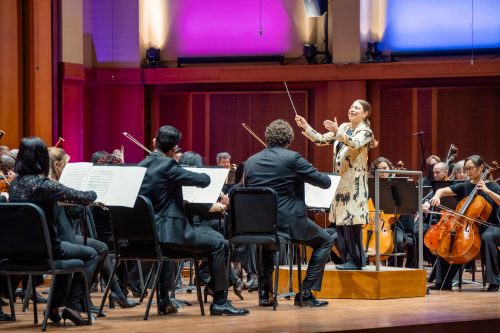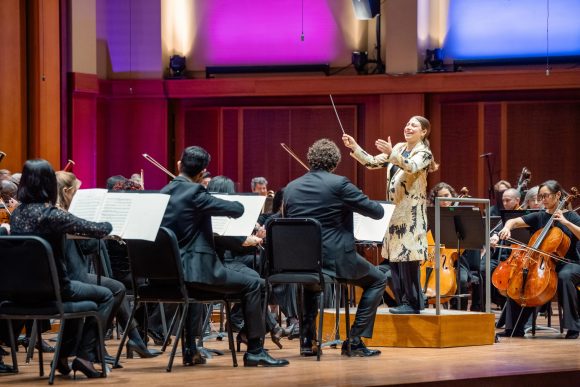 United States Meredith, Porra, Sibelius: Lauri Porra (electric bass), Seattle Symphony / Dalia Stasevska (conductor). Benaroya Hall, Seattle, 16.11.2023. (TM)
United States Meredith, Porra, Sibelius: Lauri Porra (electric bass), Seattle Symphony / Dalia Stasevska (conductor). Benaroya Hall, Seattle, 16.11.2023. (TM)

Anna Meredith – ‘Nautilus’
Lauri Porra – Entropia: Concerto for Electric Bass
Sibelius – Symphony No.5 in E-flat major, Op.82
This Seattle Symphony performance drew the largest audience I have seen so far this season. That meant a flow of positive energy and attentiveness was already surging through Benaroya Hall, even before Dalia Stasevska ascended the podium for her return visit to conduct the SSO in a lively program of new music combined with a classic by her compatriot, Sibelius.
Having missed Stasevska’s SSO debut in March 2022 – a week after Putin invaded Ukraine, the country in which she was born – I was particularly interested in experiencing what all the fuss is about firsthand. Her ability to transmit a sense of focused, joyful discovery while shaping a performance impressed me. The charisma is real.
The program playfully updated that stalest of templates: peppy overture followed by concerto in the first half, meat-and-potatoes symphony in the second. In this case, the overture was Anna Meredith’s ‘Nautilus’, which began as a hybrid acoustic-electronic, synth-pop-fueled track for her debut album, Varmints (the YouTube video version is especially enjoyable). Meredith reorchestrated it for Stasevska’s inaugural concert as chief conductor of the Lahti Symphony in 2021. In this format, ‘Nautilus’ is a kickass, compact, brutally brassy take on the fanfare as a curtain raiser. Driven by hyper-ostinatos that briefly threaten to tear apart the wall of sound about two-thirds through, it struck me as a pop-art manifestation of the impulse that powers the Toccata at the top of Monteverdi’s L’Orfeo.
There was also plenty of raw power in the electric bass concerto by Lauri Porra that followed. But Entropia, as the work is titled, embraces a wide spectrum of moods and textures, including moments of delicate mystery. Porra, who is married to Stasevska, joined the SSO to perform as the soloist. In introductory remarks, he praised Seattle as the city where the electric bass was invented and introduced to the world in the 1930s by Paul Tutmarc, and he referred to the symphony orchestra as a glorious invention. A major challenge in composing the concerto, he pointed out, was to creatively balance the potentially overpowering sound world of the solo instrument with that produced by the acoustic ensemble.
Lasting about a half hour, Entropia tries out various solutions to what might seem an outright incompatibility. The opening suggests that a Creation story is unfolding, showcasing Porra’s talent as an imaginative colorist in his blends of electronic wisps with percussion and harmonics. The tall, expressive musician made ample use of the pedals and sonic enhancements of his instrument. Transitions were mysterious, not always clearly motivated, recalling (to this taste) a cinematic sense of narrative – or maybe even one closer to what you find in video games – as in the cliffhanger-ending-of-a-section trope. One theme evoked the world of The Hunger Games.
I found the most original and interesting parts to be those where Porra underscored the alienness of his bass, generating bizarre, even otherworldly sounds that have no acoustic equivalent. It was intriguing to hear these passages juxtaposed with orchestral musings like a ravishing mini-cadenza by concertmaster Noah Geller. The paradox is that his wonderfully fresh and sonically provocative updating of the concerto idea at the same time drew on a rather conservative aesthetic – above all, following a fabulous, accompanied cadenza, for the somewhat saccharine rapprochement dramatized in the closing section. I could not parse it with the thermodynamic concept of entropy promised by the title: rather than an increase in disorder, Entropia culminates in a glowing harmonic convergence between electric bass and orchestra. Still, Porra shows considerable skill and imagination in tracing this journey over a long arc. I am eager to hear more of his music.

Stasevska’s work in keeping textures as balanced as possible – except for a few roaring outbursts from the electric guitar meant to be bone-rattling tidal waves of sound – was remarkable. She then turned from conducting her husband’s music to a monument by her great-grandfather-in-law. (Porra is a great-grandson of Jean Sibelius.)
The Fifth Symphony can seem an entirely different piece of music according to the conductor’s understanding and connection to Sibelius’s sonic universe. It also requires a keen attention to subtle transitions that need to be executed with a kind of sleight of hand – an art of disguising art. Stasevska brought out some tangents that I found to be wonderful discoveries: the thrilling ride into the first movement coda, a frenzy that nevertheless remained ecstatic. I have never quite heard the degree of warmth she drew from the woodwinds in the variations.
Best of all was Stasevska’s approach to the final movement, which allowed it to evoke an out-of-body elation that continued to surprise after its first revelation wheels across the orchestra. She also brought out the sense of tonality about to crack in the lurching basses near the end. The only letdown for me was in the stack of pillar chords that famously end the piece: it is almost impossible to make the timing between them work just right. But the effect of the whole was exhilarating and genuine. Stasevska brought out the best from these wonderful musicians.
Thomas May
